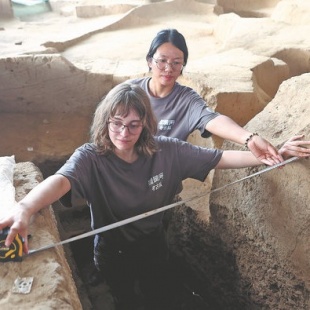Foreign students get hands-on experience at digs


From Virginia classrooms to excavating 3,000-year-old tombs in Beijing's heatwave, Virginia Commonwealth University junior Kaitlyn Jenkins experienced archaeology's front lines this summer — drenched in sweat.
From June to earlier this month, a group of university students from North America traveled to Beijing to participate in an international field archaeology summer program at the Liulihe site, which dates back more than three millenniums and covers 5.25 square kilometers in the Fangshan district on the capital's southwestern outskirts.
The site was where the capital of Yan vassal state of Western Zhou Dynasty (c. 11th century-771 BC) was located. It marked the beginning of Beijing as a city.
The students, mostly anthropology majors, engaged in hands-on excavation of ancient ruins, attended academic lectures, and joined specialized seminars — bringing textbook theories to life.
Although Jenkins once had field study experience in Ireland, it's her first ever experience to dig a tomb herself. For her, the true test came in detecting the faint boundaries where ancient builders had cut through earth to inter coffins — a task demanding surgical precision.
She had to gently scrape the ground, identify soil textures and colors, and outline layers. She describes these partition lines between walls as "very minute differences" invisible to untrained eyes.
"You have to have a really good eye for detail and probably lots of practice to get good at it," she says.
She observes that compared to Ireland's more flexible cataloging methods, China's approach is stricter and more systematic. While Ireland uses X-Y axis measurements, China employs a single baseline method.
"Though some techniques here are older than those used in America and Ireland, they're highly practical," she notes.
Jenkins says that working at the relic site has deepened her appreciation for the country's archaeological achievements.
"I do hope I can learn more about Chinese history in the future because it's just been so interesting to see, for example, what they had 3,000 years ago was so much more advanced compared to a lot of other places," she adds.

Among the participants was Haley Olinyk, a Chinese studies major from the University of British Columbia in Canada. Growing up in a town near Vancouver, she developed a fascination for Chinese culture, firmly believing that "there's so much you can learn from cultures and groups so different from your own".
Olinyk was a former visually impaired student athlete who won gold at a world junior goalball championship in 2015. She notes the Chinese national goalball teams' strong performances in the Paralympics — factors that ultimately led her to pursue Chinese studies.
During the excavation, Olinyk emphasized how working on commoners' tombs provided a grassroots historical perspective.
"We're taught to focus more on everyday people's lives — not just elites — because it is the regular people ... that shape a lot of the culture," she says.
It's the second year for the international field archaeology summer program to be held.
Zhang Zhonghua, director of the Beijing Institute of Archaeology — one of the program's organizers — stated that the program also offers cultural tours for international participants, allowing students to gain an in-depth understanding of the diversity of China's cultural heritage and its historical context.
They've been to such places as the Great Wall, the Palace Museum and the Capital Museum.
Olinyk says that during their visit to the Palace Museum, she was impressed by how feng shui was integrated into the construction of the Forbidden City.
"In North America, we might consider basic principles like placing an object here or there to make a room look better," she says. "But this is a very watered-down version of the actual tradition, which is far more intricate, involving geomancy, numerology and precise mathematical calculations."





































